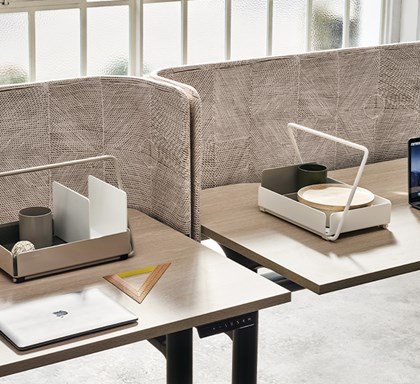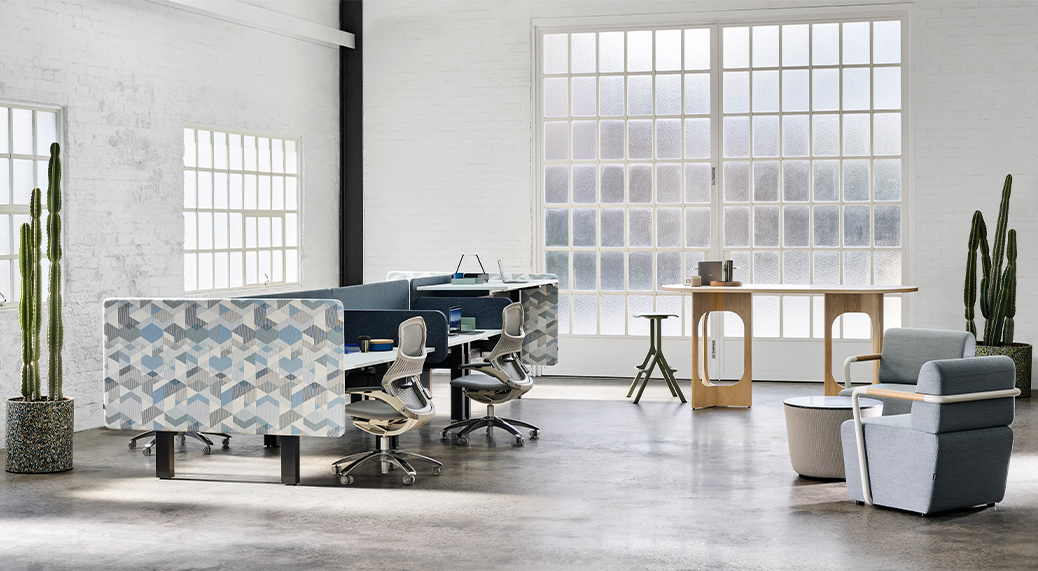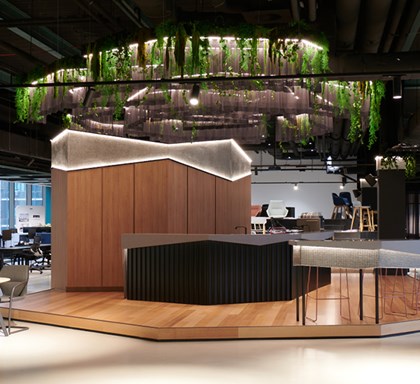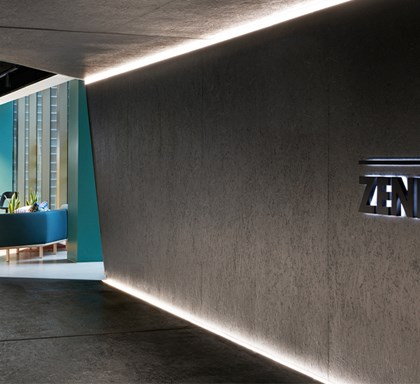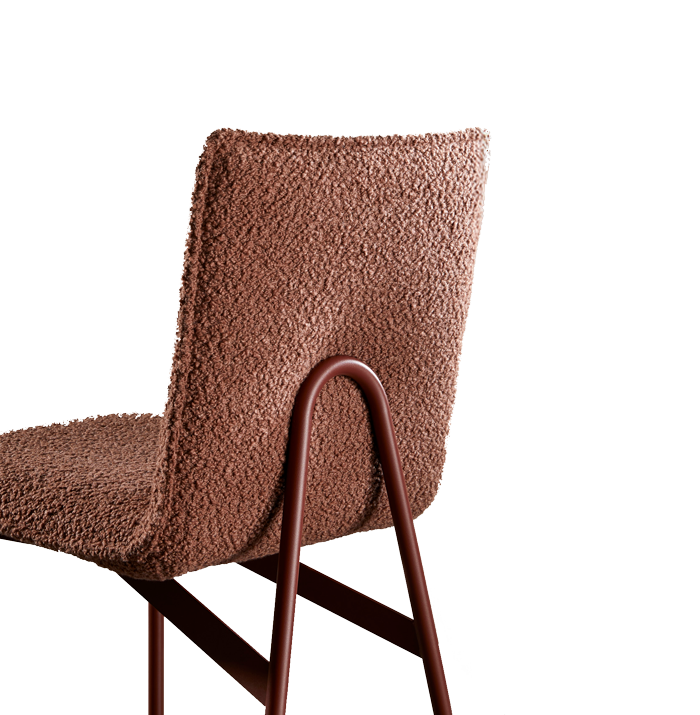Since the COVID-19 pandemic caused a global decamping of offices, strategies for productivity at home and setting up living-room workstations have been abundant. Now, as the light at the end of the tunnel comes into view, the design community must rally to make employees feel safe as we begin the journey to reoccupy shared spaces.
The Association of Consulting Architects Australia (ACA) conducted three ‘pulse check’ surveys across the period of the pandemic to understand the impact of COVID-19 on architecture practices. Their most recent data reveals widespread uncertainty in the A&D industry about how best to return to the office.
How should the business balance remote working with collocation? How should office design re-prioritize hygiene and wellness? Now that remote working scenarios have been stress-tested and proven largely effective, what will the physical office need to offer to create an attractive occupant experience?
In the short term, businesses have been ‘managing’ their way through the disruptions caused by the pandemic. Now, to navigate the post-pandemic workplace in the long term, we will need to ‘design’ our way through.
For our Workplace Experience series, we consulted some of Zenith’s market leading clients to provide a comprehensive vision of the future of office design. In this first edition, we explore how the definition of the health-centric workplace will change post-pandemic.
Agility begets flexibility
The move toward agile workplace design that took place pre-pandemic will have the unintended benefit of enabling office flexibility post-pandemic.
The abrupt change to working arrangements caused by the pandemic introduced many businesses to the tenets of the agile working for the first time; a model in which employees operate within the guidelines of a task but without the boundaries of how that work is achieved.
More than half of the near 400 architecture practices that responded to the ACA’s recent ‘pulse check’ said that there are positive aspects of this forced flexibility that they want to retain into the future.

Zenith’s clients see agile solutions only achieving greater popularity as physical distancing restrictions in combination with fluctuating numbers of in-office staff forces adaptation.
“Designing with flexibility and agile working will still be key as it allows users to adapt their physical environment to meet dynamic needs, particularly in volatile times,” predict Penny Sloane and Ellen Yap, Managing Director and Practice Director respectively of interior design consultancy Siren Design.
The ACA’s data reveals that practices have a variety of plans for returning to the office. 186 practices are allowing for individual flexibility as to when an employee returns to work in the office.
Practices are also prioritizing the return of employees who need to collaborate face-to-face. A rotation system for in-office times as well staggered start and finish times are also being implemented by practices.

A complementary combination of working from home and working from work may become the new normal for many businesses.
Principal of Interior Design at ZMH, Martin Dutry predicts that this balancing act will lead to home office design becoming part-and-parcel of the office design solution, with pack-and-go desks included in an employee’s toolbox.
Redistributing space
A general reduction in the density of the workspace was forecast by many of Zenith’s clients.
“Humans fundamentally do need to interact to solve problems and socialise, but it may mean moving away from crowded central spaces and shifting towards a set of spread out smaller spaces so it is harder to spread a communicable disease en masse,” says Melanie Porrins, associate at Woods Bagot
There were many solutions to better distribute the workspace for post-pandemic cautiousness, from reorganizing work groups to abide by physical distancing to the introduction of office design tools such as partitions to modify interactions.
“Social distancing requirements imply that staff will be required to keep increased distances around meeting table for example,” says Martin Dutry, “an 8 person meeting table may become a 4 person meeting table and so on.”
What may emerge is a hybrid between in agile working system and activity-based working in which workstations are designated for a particular type of activity.
“There will be much more flexibility built into furniture and layout to deal with possible future pandemic. But it will still be accommodating a variety of work settings. In fact, many of recent surveys on WFH have highlighted that people will want to come into office to collaborate and socialise, not to do individual work which can be easily done at home. Hence, that would mean less need for typical individual style desks and higher usage of collaboration type work settings,” forecasts Kahn Yoon, Director of International Projects at Global Workplace design firm M Moser.
Although offices with agile working solutions already in place may be one step ahead when it comes to abiding by physical distancing restrictions, a new definition of the ‘agile’ workplace will emerge post-pandemic: an office’s capacity to respond to a crisis.
“Whilst there is a knee jerk reaction on implementing acrylic sneeze guards and pulling desks apart for safe distancing, it will be more about building in flexibility to adapt quickly to any kind of pandemic or other unknown crisis in future,” says Yoon.
Digital communication spaces
The pandemic saw working life rapidly reimagined in the digital space. Employees quickly upskilled to command the video conferencing and file sharing technologies that allowed productivity to continue.
As a result, workforces will emerge from the pandemic with improved technological capabilities and offices must adapt to integrate these digital communication tools into their design.
As Kahn Yoon explains, “the new norm is that even though everyone is in the same city, it will always be a mix of physical and dial-in meetings due to WFH”.
“Every meeting space will have to integrate AV capabilities, and implement easy VC option for individuals, whether by provision of phone rooms or acoustic panels.”
Greater comfort with using digital tools will mean that the office space may be used as much for virtual meetings as they will be for face-to-face interactions.
Contactless technology and hygienic materiality
Hygiene has been the number one priority for many businesses contemplating the move back to the office. According to the ACA’s recent ‘pulse check’, 87 percent of responding practices are preparing new hygiene processes for the eventual return to the office.

Touch-free, voice-activated technologies could replace current systems, particularly in reception areas where we have already started to see digital systems take over.
“Smart and integrated building systems for touch-free, seamless user experience should be considered a necessity, not a luxury/optional extra,” says Ellen Yap and Penny Sloane of Siren Design
Seamless surfaces, antimicrobial fixtures and coatings, washable fabrics, durable to frequent sanitation will be integral to employees feeling safe returning to the office.
However it is vital that the tactility of the office space not be lost in this transition. Interior designer’s knowledge and understanding of finishes and materiality will be invaluable in creating safer workspaces that remain warm and inviting.
Many of these lessons will be transferrable from healthcare design in which the hygienic properties of surfaces, textiles and furniture have long been prioritized in parallel to aesthetic.
Emphasising office culture
The power and allure of the shared space has never been more powerfully felt. While technology has enabled us to ‘meet’ online, the office as a locus for community, collaboration and face-to-face ideation has become clear.
Zoom conferencing and wellbeing check-ins cannot replace the multi-sensory experience of unmediated interactions with your team in a shared-space. Now that working from home has proven successful, the physical office must lean into what it can offer that the Zoom meeting cannot.
The question then is why/what will be the factor that will get people to go back to the office?
One possible outcome is that the office will be viewed more strictly as a forum for face-to-face collaboration and furniture that allows for this collaboration, with physical distancing in mind will increase in popularity. Another version of the post-pandemic office reality sees it become a space to do focused work when conditions at home don't permit.
Workspaces that foster wellbeing and enable collaboration and social interaction safely will be fundamental to attracting people back to the office and re-generating workplace trust and culture.
Regional Manager of M Moser’s Singapore office, Stephen Lyon views the sudden ubiquity of remote work as a chance to harness only the best of the office environment. “I see it as an opportunity to remove the mundane and improve the social interaction. Work from home and go to the office to socialise,” he says.
Conclusion
To forecast anything in unprecedented times is to gamble. What we’re sure of is the innovation that will come from this crisis. There will be new designs, new materiality, new applicability for existing models and novel collaborations across sectors. To seize this moment, designers must push for these developments and redesign a workplace in which agility also means adaptability to a crisis.
View more here
Contact us today for all your return to office needs.
info@zenithinteriors.com
